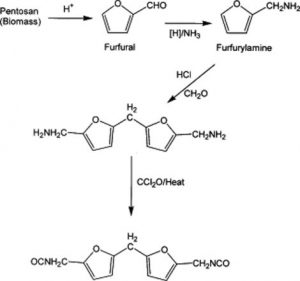Furfural is an almond-scented, oily, colorless liquid that turns yellow to dark brown when exposed to air. It is used as a solvent for refining lubricating oils, as a fungicide and weed killer and in the production of tetrahydrofuran, an important industrial solvent. Cobs contain 30-32% pentosane (hemicellulose) is a simple sugar (polysaccharide) which is a raw material in making furfural. The use of corn cobs as raw the materials for furfural production is very beneficial because, among other raw materials for furfural production, corn cobs contain the most pentosane.
Related projects:- FURFURAL FROM BAGASSE & CORNCOBS

Production of Furfural
An M-O-L acid (mineral acid, organic acid, and Lewis acid)-catalyzed integrated process for furfural production from corncob was proposed to improve corncob conversion and furfural selectivity. First, the co-catalysts of sulfuric acid and acetic acid were investigated for their impact on furfural production. Sulfuric acid as a pretreatment catalyst was mixed with corncob before the experiment. Acetic acid, which is a byproduct of hemicellulose hydrolysis, was fed together with steam. The results showed that the cooperation of sulfuric acid and acetic acid decreased the total acid consumption dramatically. FeCl3·6H2O was also investigated as a co-catalyst in an effort to enhance the conversion of xylose to furfural and decrease furfural degradation. The integrated catalytic process achieved the highest furfural yield of 68.04% through the use of M-O-L acid under a reaction temperature of 180°C, 3v% acetic acid, 4.0 wt.% sulfuric acid of 0.6 mL/g liquid to solid ratio, and 5 g FeCl3·6H2O per 100 g of biomass.
Related book:- Handbook On Chemical Industries
Usage of Furfural in Various Industries
Furfural is broadly used as a solvent or intermediate in several end-use industries, including foundry, agriculture, paints & coatings, pharmaceuticals, refineries, chemicals, automotive, and construction. The growing construction sector is projected to supplement the demand for the product in several refractory materials including ceramics, bricks, and fiberglass composites over the forecast period.
In addition, surging demand for sustainable products due to the depletion of fossil fuel resources is estimated to drive the demand. At present, furfural production is characterized by outdated manufacturing technologies, high steam usage, and high acid consumption, which lead to considerably low product yield or output.
As a result, many companies are focusing on the development of new processes to decrease the overall energy consumption and upsurge the product yield during the purification step. Manufacturers are inclined toward using a combination of the most effectual biomass to chemical techniques occasioning in a significant decline in operational costs.
Market of Furfural Globally
The global furfural market size was estimated at USD 814.6 million in 2019 and is expected to grow at a compound annual growth rate (CAGR) of 5.0% from 2020 to 2027. The rising importance of bio-based solvents as a consequence of increasing environmental concerns is anticipated to boost the product demand in solvent applications over the forecast period.
Corncobs raw material segment led the global market with a share of over 73%. It is estimated to retain its dominant position throughout the forecast years due to the extensive use of the raw material in the production of furfural. The yield from corncob is the maximum, thus, marking corncob the most desirable raw material for production. In addition, corncob, when used as a biomass feedstock, delivers promising opportunities for renewable energy creation.
Related videos:- Chemicals (Organic, Inorganic, Industrial)
Conclusion
“Furfural from corn cobs” is the project report by NPCS the report covers all the important aspects of the business. The report then helps an entrepreneur identify the target customer group of its product. It further helps in making sound investment decision by listing and then elaborating on factors that will contribute to the growth of product consumption in India and also talks about the foreign trade of the product along with the list of top importing and top exporting countries. Report includes graphical representation and forecasts of key data discussed in the above mentioned segment. It further explicates the growth potential of the product.
Noo_Art21